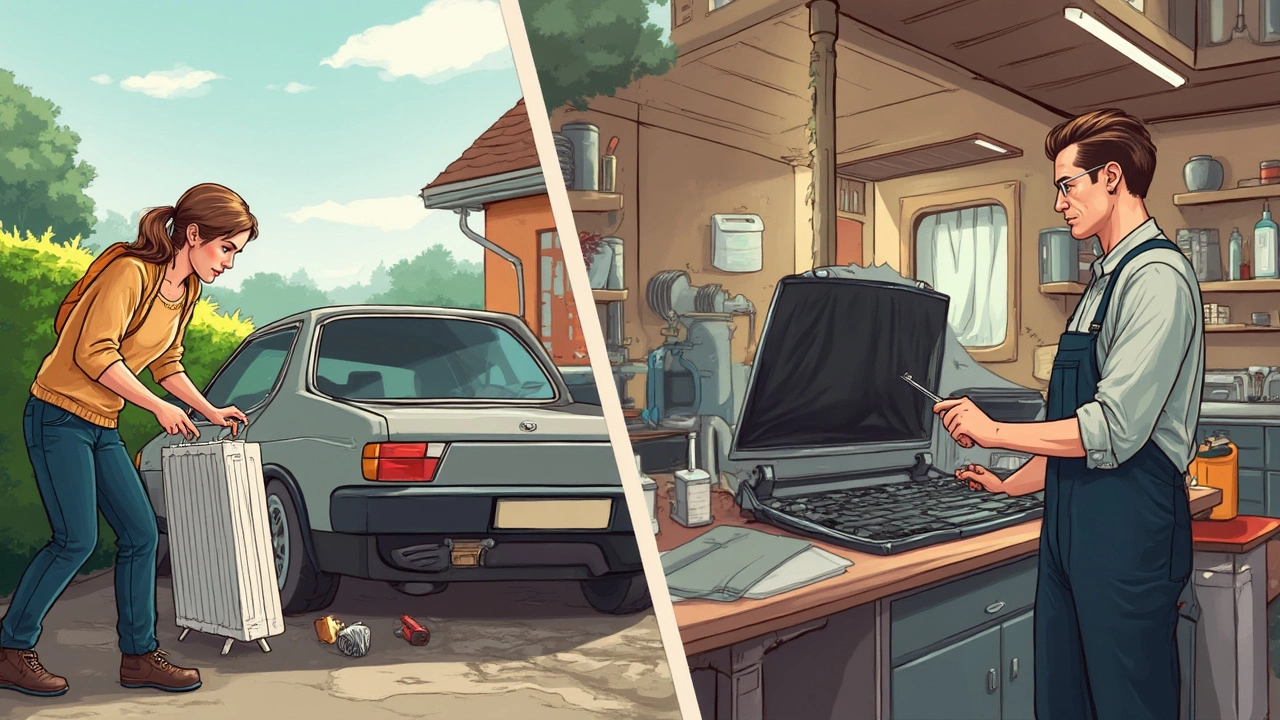A busted radiator feels like your car's way of saying, “Gotcha.” Coolant bubbling over, weird puddles under the hood, or that temp gauge inching up? That’s your car crying for help. Before you even think about dropping hundreds on a brand-new radiator, let’s talk about what you can actually do to fix the one you’ve got. Most people skip straight to replacement, but that’s not always necessary—and definitely not always the smartest move.
If the leak isn’t massive or the clog isn’t too far gone, there’s a good shot you can patch things up, at least for a while. Sometimes, a quick fix buys you months (or even years) before you ever have to swap out the whole thing. And if you’ve ever wondered why radiators fail in the first place, it’s usually because of poor maintenance, old coolant, or cheap replacement parts. So, it’s not always the radiator’s fault. Sometimes, a bit of smart repair keeps you on the road and your wallet intact.
- Signs Your Radiator Needs Attention
- Temporary Fixes vs. Real Repairs
- DIY Repairs That Actually Work
- When It's Time to Replace
- Tips to Avoid Radiator Problems
Signs Your Radiator Needs Attention
Your car radiator repair plan starts with spotting the signs before you end up stranded. The most obvious is the temperature gauge creeping into the red. If your dashboard light shows your engine running hot, that’s a warning—don’t ignore it. Overheating engines can trash way more than just your radiator.
You might notice coolant dripping under your car. Usually, it’s bright green, orange, or pink and has a sweet smell. A damp spot under the front of your car, especially after parking awhile, screams “radiator leak fix needed.”
Listen for strange sounds. Bubbling or hissing from under the hood usually means hot coolant is escaping or boiling. When coolant gets low due to leaks, your heater might blow cold air even when cranked. That’s because the system doesn’t have enough fluid to keep up.
Sometimes, a bad radiator clogs with rust or debris. If you see rusty or sludgy coolant in the reservoir, you’ve probably got a coolant issue. A drop in coolant level with no visible leak is another red flag—your radiator might be leaking internally or it could be evaporating through small cracks.
- Temperature gauge in the red
- Visible coolant leaks or puddles
- Strange noises (hissing, bubbling)
- Sludge or discoloration in coolant
- Heater not working right
- Constantly topping off coolant
Here’s a quick look at some common radiator problems and what they might mean for your DIY radiator skills:
| Symptom | Possible Cause |
|---|---|
| Coolant leak under car | The radiator or a hose is cracked or loose |
| Engine overheating | Low coolant, clogged radiator, or bad thermostat |
| Brown, sludgy coolant | Rust or debris clogging the radiator’s core |
| Sporadic heater function | Low coolant or trapped air in system |
Catching these signs early means you’ve got a shot at fixing stuff before it gets ugly (and expensive). It also helps you decide when a quick fix is possible or when it’s time to let a pro handle it.
Temporary Fixes vs. Real Repairs
This is where most people get tripped up. When you’re dealing with a car radiator repair, everyone wants the quick fix that’ll get them home—or at least through the week. But not all fixes are equal, and some are really just Band-Aids, not real solutions.
Let’s break down what’s temporary and what actually qualifies as a solid repair:
- Radiator leak sealant: This stuff comes in a bottle and you just pour it into the radiator or reservoir. It’ll usually plug up tiny leaks for a little while, sometimes long enough to squeeze out another few months before doing major radiator leak fix. But don’t count on it for big holes or long-term driving. Some sealants can also gum things up inside, making future repairs messier.
- Epoxy or JB Weld: Got a small crack or pinhole you can actually see? Clean the area, slap on some epoxy, and let it cure. It works for hairline cracks, especially on plastic tanks found on modern radiators. Just remember, heat and pressure are brutal—this isn’t a forever fix.
- Duct tape or zip ties: Desperate? These are only really for emergencies or short drives to the shop. They won’t stand up to hot coolant for long, but might help you limp home.
If you want something more than a quick patch, you’ve got a few real repair options:
- Professional soldering or brazing: For copper or brass radiators, a radiator shop can solder leaks or cracks. It’s old school, but it works. Not an option for most newer aluminum/plastic units.
- Core replacement: Sometimes, a radiator shop can replace just the core and reuse the tanks. This option is legit, but often close in cost to a new radiator, depending on your car.
- Flushing out blockages: If your issue is a clog, a power flush with a top-notch coolant flush machine can push out gunk and restore flow. Just pouring in a cleaner and hoping for the best usually doesn’t cut it if the clog's bad.
How effective are quick fixes? A 2023 survey by a major auto parts retailer found that 49% of leak sealant users said their temporary fix lasted less than two months. Only 16% got over a year without a real repair. Those numbers say it all—temporary fixes are just that: temporary.
| Fix Type | Average Lifespan | When to Use |
|---|---|---|
| Leak Sealant | 1-6 months | Small leaks, quick relief |
| Epoxy | 1-12 months | Visible cracks, slow leaks |
| Solder/Braze | Years | Copper/brass radiators |
| Core Replacement | 5+ years | Major leaks, heavy use |
The smart move? Use the quick tricks to get moving, but don’t trust your engine’s life to them. If the leak comes back or you spot more problems, invest in a real radiator repair or replacement before things get ugly.

DIY Repairs That Actually Work
If you discover a car radiator repair is needed, don’t freak out. You’ve got a few decent options before you cough up for a full replacement. Some fixes take just an afternoon and a couple of basic tools. Here’s what usually does the trick with most home repairs.
Radiator Stop Leak Products are the quickest Hail Mary play. You’ll find bottles from brands like Bar’s Leaks or BlueDevil at most auto parts stores. Pour it straight into the radiator or the overflow tank, let your engine run, and cross your fingers. These products use tiny particles to plug small leaks, so they’re best for pinhole or hairline cracks but not massive holes. Experts say you could get a few months or even longer if your radiator isn’t already halfway to the scrapyard.
- Drain, Flush, and Refill: Sometimes, gunk or rust clogs up your radiator, causing those heat problems. Draining your old coolant, flushing the system with a garden hose or a flush product, and refilling it with fresh coolant can make a world of difference. This can restore flow and buy more time without big repairs.
- Epoxy or JB Weld: For small cracks or leaks at the seams, a two-part epoxy like JB Weld is a game changer. Clean the spot, rough it up with sandpaper, mix the putty, and smear it right on. Let it dry overnight—the fix isn’t glamorous, but it often holds surprisingly well against radiator pressure.
- Clamp and Rubber Patch: For hoses or side-tank leaks, some folks use a bit of rubber hose (cut from an old radiator hose if you have it) and a couple of hose clamps. Wrap the rubber around the leaking spot and clamp it down tight. It’s ugly but often works, especially if you’re stranded somewhere.
| Repair Method | Success Rate (Short Term) | Best For |
|---|---|---|
| Stop Leak Additive | 60-80% | Small leaks, emergency fix |
| Epoxy Repair | 70-90% | Seam cracks, pinholes |
| Flush and Refill | 80-95% | Clogs, overheating |
| Clamp & Rubber Patch | 50-70% | Hose, tank leaks |
Keep in mind, if the leak is huge or the radiator is crusted with corrosion, these tricks might only buy you some time. But for a lot of everyday radiator leak fix jobs—especially when you catch trouble early—you can pull off a DIY radiator repair that gets your car back on the road fast.
When It's Time to Replace
Alright, let’s get real. As much as you want to save your current car radiator, sometimes you’re just throwing money at a lost cause. Radiators don’t last forever—on average, they’ll last about 8 to 10 years, maybe less if you’ve skipped maintenance or used low-quality coolant. If you’re wondering, “How do I know it’s time for a new one?” here’s what actually matters.
- Massive leaks: If your radiator leaks faster than you can refill, no sealant or quick fix will hold for long. You’ll just waste coolant and risk overheating.
- Rust or sludge inside: Take off the cap and spot brown sludge or chunky rust inside? That’s a good sign your radiator’s packed it in. No DIY radiator flush will save it at that stage.
- Visible cracks or broken fins: Any big physical damage usually means the core is done for. Small cracks might get a temporary fix, but the big ones only get worse.
- Constant overheating: If your temp gauge is always in the danger zone, even after repairs or flushing, the core’s probably blocked deep inside and that’s not something you can fix in your garage.
- Mixing coolant and transmission fluid: Some cars run coolant and transmission lines through the same radiator, and if you ever spot a milkshake-like mix, the internal walls are shot—replacement is a must.
Here’s a quick comparison so you can spot when you’re wasting time versus when there’s hope:
| Issue | Can You Fix? | Replace Needed? |
|---|---|---|
| Small External Leak | Possibly, with sealant or solder | No |
| Large Crack | No | Yes |
| Minor Rust | Flush or chemical cleaner | No |
| Heavy Rust/Sludge | Not really | Yes |
| Coolant/Fluid Mixing | No | Yes |
One last thing: don’t wait until a bad radiator blows your head gasket or fries your transmission. Once the problems above pop up, all the radiator leak fix tricks won’t save you. It’s better to swap it out now than get stranded or wreck your engine. If you’re not sure, get a second opinion from a shop that’ll actually show you the problem up close—don’t just go off the first quote you hear.

Tips to Avoid Radiator Problems
Keeping your car radiator healthy isn't rocket science, but most people ignore the basics until things go south. Every car owner should have a few habits locked in to stop leaks, clogs, and expensive breakdowns. Want your radiator repair bills to drop? Start with these practical moves.
- Flush that system regularly. Manufacturers recommend a coolant flush every 30,000 miles or every two to three years. Old coolant gets sludgy and lets gunk build up, which leads to clogs or corrosion. Don’t skip it—this is probably the top way to keep your radiator doing its job.
- Use the right coolant blend. Generic coolant sounds cheaper, but using the kind meant for your vehicle helps avoid chemical reactions with your car’s metal. Mixing coolants can be just as bad—it can cause deposits that mess with flow or eat away at your radiator from the inside.
- Check for leaks early. When you see puddles under your car or smell something sweet (that’s coolant), pop the hood. Catching leaks early means you can often use a quick radiator leak fix and avoid a roadside meltdown later.
- Inspect hoses and clamps. A cracked or loose hose can lose pressure and put stress on the radiator. Every oil change, glance over the hoses for bulges, cracks, or leaks. Squeeze them—if they feel mushy or brittle, swap them out.
- Keep the radiator clean. Leaves, bugs, dirt, and debris block airflow. Once a season, grab a low-pressure hose and spray the outside of your radiator to clear it. Don’t use high pressure—it can bend the fins.
If you like numbers, here’s something real: More than 25% of all roadside breakdowns are related to coolant issues. That’s how important simple checks and flushes are.
| Maintenance Step | Recommended Frequency |
|---|---|
| Coolant flush | Every 30,000 miles / 2-3 years |
| Check hoses/clamps | Every oil change |
| Inspect for leaks | Monthly |
| Exterior cleaning | Every season |
Staying on top of these tips is way easier (and way cheaper) than dealing with surprise repairs or a new radiator.






